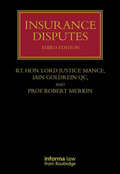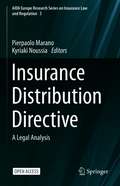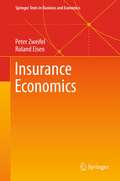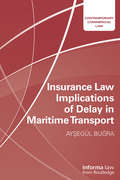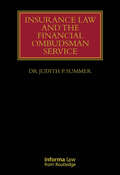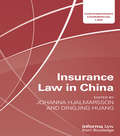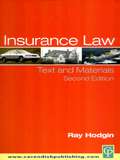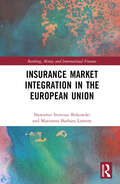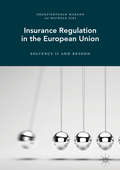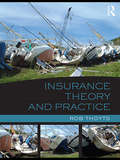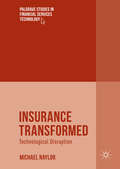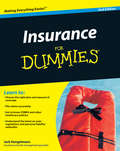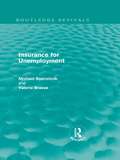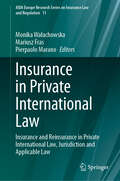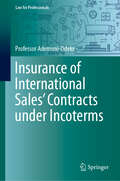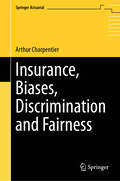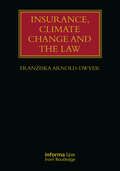- Table View
- List View
Insurance Disputes
by IAIN GOLDREIN; ROBERT MERKINWritten by an impressive team of specialist contributors, Insurance Dispute is the authoritative guide to litigation for both the insurer and the insured. Divided into two parts – principles of law and their practical use in individual types of insurance, it aims to identify and resolve questions such as: • How should the claimant handle a dispute? • Is the claim within the cover? • When should an insurer dispute cover? • What steps can an insurer take to deny cover? Updated and revised to include new chapters on marine insurance, the Financial Ombudsman Service and ATE insurance, Insurance Disputes is essential reading for anyone involved in insurance law and litigation.
Insurance Distribution Directive: A Legal Analysis (AIDA Europe Research Series on Insurance Law and Regulation #3)
by Kyriaki Noussia Pierpaolo MaranoThis open access volume of the AIDA Europe Research Series on Insurance Law and Regulation offers the first comprehensive legal and regulatory analysis of the Insurance Distribution Directive (IDD). The IDD came into force on 1 October 2018 and regulates the distribution of insurance products in the EU. The book examines the main changes accompanying the IDD and analyses its impact on insurance distributors, i.e., insurance intermediaries and insurance undertakings, as well as the market. Drawing on interrelations between the rules of the Directive and other fields that are relevant to the distribution of insurance products, it explores various topics related to the interpretation of the IDD – e.g. the harmonization achieved under it; its role as a benchmark for national legislators; and its interplay with other regulations and sciences – while also providing an empirical analysis of the standardised pre-contractual information document. Accordingly, the book offers a wealth of valuable insights for academics, regulators, practitioners and students who are interested in issues concerning insurance distribution.
Insurance Economics
by Peter Zweifel Roland EisenInsurance Economics brings together the economic analysis of decision making under risk, risk management and demand for insurance by individuals and corporations, objectives pursued and management tools used by insurance companies, the regulation of insurance, and the division of labor between private and social insurance. Appropriete both for advanced undergraduate and graduate students of economics, management, and finance, this text provides the background required to understand current research. Predictions derived from theoretical argument are not only stated but confronted with empirical evidence. Throughout the book, conclusions summarize results, helping readers to check their knowledge and understanding. Issues discussed include paradoxa in decision making under risk, selection of favorable risks by insurers, the possibility of a "death spiral" in insurance markets, and future challenges such as re-regulation in the wake of the 2007-09 financial crisis and the increasing availability of generic information.
Insurance Fraud Casebook: Paying a Premium for Crime
by Joseph T. Wells Laura HymesReal case studies on insurance fraud written by real fraud examiners Insurance Fraud Casebook is a one-of-a-kind collection consisting of actual cases written by fraud examiners out in the field. These cases were hand selected from hundreds of submissions and together form a comprehensive picture of the many types of insurance fraud—how they are investigated, across industries and throughout the world. Entertaining and enlightening, the cases cover every type of insurance fraud, from medical fraud to counterfeiting. Each case outlines how the fraud was engineered, how it was investigated, and how perpetrators were brought to justice Written for fraud examiners, auditors, and insurance auditors Other titles by Wells: Fraud Fighter and Corporate Fraud Handbook, Third Edition Edited by Dr. Joseph T. Wells, the founder and Chairman of the Association of Certified Fraud Examiners (ACFE), the world's leading anti-fraud organization, this book reveals the dangers of insurance fraud and the measures that can be taken to prevent it from happening in the first place.
Insurance Law Implications of Delay in Maritime Transport (Contemporary Commercial Law)
by Aysegul BugraDelay in a marine adventure is an important and frequent phenomenon of maritime transport as it affects various parties and their interests. Insurance Law Implications of Delay in Maritime Transport is the first single book to deal specifically with this issue in the context of insurance law. The book addresses the losses and expenses that may arise from delay or loss of time in maritime transport, the types of insurance available covering or excluding losses arising from it and the impact of delay on voyage policies. The author, Ayşegül Buğra, critically examines and evaluates the scope of several different types of marine insurance policies, including but not limited to: hull and machinery, cargo, freight, loss of hire and marine delay in start-up insurance. Furthermore, the book analyses the current law by tracing back the relevant common law authorities to the 18th century and examines the wordings used in practice from that time to today with a comprehensive and critical approach. This unique text will be of great interest to legal practitioners, shipping professionals and academics alike.
Insurance Law and the Financial Ombudsman Service (Lloyd's Insurance Law Library)
by Judith SummerInsurance Law and the Financial Ombudsman Service is an in depth look at the workings and insurance decisions of the Financial Ombudsman Service. The book analyses how the Ombudsman Service decides insurance cases and compares its approach to that of a court. This book sets out the rules, procedure and approach of the Ombudsman Service, succinctly summarises the relevant insurance law and compares and analyses it against a comprehensive review of material about insurance complaints gathered since the formation of the Ombudsman Service in 2001.
Insurance Law in China (Contemporary Commercial Law)
by Johanna Hjalmarsson Dingjing HuangThe Chinese insurance market is expanding enormously as risk adversity takes hold in the economy while the role of the State as guarantor of commerce is gradually reduced. In addition, insurance is a heavily regulated field with detailed contract law stipulations. An introduction to regulation and contract law and an understanding of current issues is essential for someone seeking to do business in the Chinese market. Insurance law is also a field that translates well from one jurisdiction to another, and academics will be interested in understanding how issues are dealt with in another jurisdiction. The book seeks to present and discuss current topics in Chinese insurance law and regulation to an English-speaking audience knowledgeable of common law insurance law and international insurance business. The combined effect of the papers is to present Chinese insurance law to an audience unfamiliar with Chinese law, in a readable and accessible essay chapter format. Each chapter is written by an expert in the field and goes beyond a basic introduction to provide in depth well-researched information and academic analysis on the topic in question.
Insurance Law: An Introduction (Practical Insurance Guides)
by Robert MerkinInsurance Law – An Introduction is essential reading and will provide you with a thorough understanding of all the main areas including motor, property, financial and marine insurance. The book contains the latest case law and best practice with reference to problem areas including fraudulent claims, third party rights against insurers and construing insurance terms. Comprehensive guidance on all key areas from the duty of utmost good faith to choice of law and jurisdictional issues is given by the leading legal experts in the insurance industry.
Insurance Law: Cases and Materials (Third Edition)
by Roger C. HendersonThis Third Edition includes many new cases and notes, as well as a thorough revamping of a number of sections and chapters. For example, Chapter 2 now brings together materials on fundamental assumptions of insurance law. A new Chapter 3 brings together a variety of materials on both judicial and legislative regulation of the insurance business. The authors designed this edition towards three primary goals: (1) To impart an understanding of basic insurance law through the cases and notes; (2) To raise fairly debatable, provocative issues, which will involve students in legal analysis and resolution; (3) To inform students about basic insurance business practices, as well as some of the more practical problems faced by attorneys, judges, and insurance regulators in the real world. The overall aim is to impart a sound foundation in law and legal analysis, an understanding of the business of insurance, and an appreciation of the role of insurance in modern society. The book is designed for either a three- or four-hour course in insurance law, but through some judicious editing it may also be used in a two-unit course.
Insurance Law: Text and Materials
by Ray HodginFirst published in 2002. Routledge is an imprint of Taylor & Francis, an informa company.
Insurance Market Integration in the European Union (Banking, Money and International Finance)
by Sławomir Ireneusz Bukowski Marzanna Barbara LamentInsurance Market Integration in the European Union offers an in-depth analysis of the mechanisms of insurance market integration and measures the degrees of this integration. It examines the operation of the EU single financial market and, against this backdrop, the regulation relating to the insurance market. In addition, the book focuses on the specificity and determinants of international insurance market development and the issues with assimilation set against other financial market segments such as money market, credit-deposit and bond and equity. It discusses the advantages and disadvantages of insurance market integration on an international scale. The authors propose a unique approach to the subject in the context of the EU and particularly in relation to the European area. They also apply new measures of insurance market integration in the EU in practice through the use of statistical data and implementation of econometric modeling. Further, they investigate how the financial and fiscal crisis has affected the insurance market in EU countries and the impact of European Central Bank monetary policy on the degrees of integration in the European area during and after the financial crisis. This book will find an audience among academics and researchers in the fields of international economics and finance and applied, financial and growth economics.
Insurance Planning
by James F. Dalton Michael A. Dalton Thomas P. Langdon Joseph M. GilliceThis book is written for undergraduate and graduate level students interested in acquiring an understanding of financial planning from a professional financial planning viewpoint. The text is intended to be used in an overall curriculum in financial planning in an Insurance course or in a course that combines Fundamentals of Financial Planning and Insurance.
Insurance Regulation in the European Union
by Pierpaolo Marano Michele SiriThis book explores the profound transformation that has taken place in European insurance legislation since January 2016. Expert contributions discuss the changes that have taken place in the supervision of insurance and reinsurance undertakings through an economic risk-based approach. They outline the European insurance market before going on to show how Solvency II and Insurance Distribution Directive (IDD) are expected to generate significant benefits and have a positive impact on all parties involved in the insurance industry, the supervisory authorities and the insured. They also show how Solvency II is likely to benefit the economy as a whole, promoting more efficient allocation of capital and risk in a financial stability framework. This volume will be of interest to academics and researchers in the field of insurance regulation.
Insurance Risk and Ruin
by David C. M. DicksonBased on the author's experience of teaching final-year actuarial students in Britain and Australia, and suitable for a first course in insurance risk theory, this book focuses on the two major areas of risk theory - aggregate claims distributions and ruin theory. For aggregate claims distributions, detailed descriptions are given of recursive techniques that can be used in the individual and collective risk models. For the collective model, different classes of counting distribution are discussed, and recursion schemes for probability functions and moments presented. For the individual model, the three most commonly applied techniques are discussed and illustrated. Care has been taken to make the book accessible to readers who have a solid understanding of the basic tools of probability theory. Numerous worked examples are included in the text and each chapter concludes with exercises, which have answers in the book and full solutions available for instructors from www. cambridge. org/9780521846400.
Insurance Settlements
by Ronald MillerInsurance Settlements Increase settlement values with this insider's guide to the insurance settlement process. Insurance Settlements opens long-locked doors to insurance claims departments, gathering the experience of more than 25 veteran claims managers, attorneys, medical experts, and adjusters. Discover in days what most plaintiffs' attorneys take years to learn. This book reveals how to: * Demonstrate to the adjuster that you know what you are doing * Determine when and what to say for maximum impact * How to help the adjuster sell your client's damages to his superiors * Draft effective demand letters * Evaluating soft tissue injuries * Break cases free from common logjams * Prove pain and suffering * Get realistic offers from adjusters * Counter common insurance settlement tactics * Value cases using traditional insurance company techniques * Obtain top dollar
Insurance Theory and Practice
by Rob ThoytsThis book provides a comprehensive overview of the theory, functioning, management and legal background of the insurance industry. Written in accessible, non-technical style, Insurance Theory and Practice begins with an examination of the insurance concept, its guiding principles and legal rules before moving on to an analysis of the market, its players and their roles and relationships. The model is the UK insurance market which is globally recognized and forms the basis of the insurance system in a range of countries in the Middle East, Africa and the Caribbean as well as Australia and Canada. The book covers the underlying ideas behind insurance transactions, together with the legal and financial principles that permit these concepts to function in the real world. Key issues considered include: the role of the constituent parts of the insurance market the operation of both life and general insurers with special reference to the operation of the Lloyd’s market the nature and function of reinsurers, brokers and loss adjusters the influence of government, both in terms of market regulation and consumer protection alternatives to the established private sector insurers, such as government schemes, Islamic insurance and alternative risk financing.
Insurance Transformed
by Michael NaylorThis book explores how a range of innovative disruptive technologies is about to combine to transform the insurance industry, the products it produces, and the way the industry is managed. It argues that unless current insurance providers react to these waves of disruption they will be swept away by new innovators. The book describes what insurers need to do to survive. The main aim is to get insurers to reimagine their industry away from the sale of a one-off product, into the sale of a series of real-time, data-based risk services. While parts of these disruptions have been discussed, this book is the first to bring all the issues together and unites them using a theoretical framework. This book is essential reading for insurance industry participants as well as to academics interested in insurance and understanding the key issues the industry currently faces.
Insurance and Behavioral Economics
by Howard C. Kunreuther Mark V. Pauly Stacey McmorrowInsurance is an extraordinarily useful tool to manage risk. When it works as intended, it provides financial protection to individuals and a profitable business model for insurance firms and their investors. But it is broadly misunderstood by consumers, regulators, and insurance executives. This book looks at the behavior of individuals at risk, insurance industry decision makers, and policy makers at the local, state, and federal level involved in the selling, buying, and regulating of insurance. It compares their actions to those predicted by benchmark models of choice derived from classical economic theory. When actual choices stray from predictions, the behavior is considered to be anomalous. With considerable sums of money at stake, both in consumer premiums and insurance company payouts, it is important to understand the reasons for anomalous behavior. Howard Kunreuther, Mark Pauly, and Stacey McMorrow examine these anomalies through the lens of behavioral economics, which takes into account emotions, biases, and simplified decision rules. The authors then consider if and how such behavioral anomalies could be modified to improve individual and social welfare. This book is neither a defense of the insurance industry nor an attack on it. Neither is it a consumer guide to purchasing insurance, although the authors believe that consumers will benefit from the insights it contains. Rather, this book describes situations in which both public policy and the insurance industry's collective posture need to change. This may require incentives, rules, and institutions to help reduce both inefficient and anomalous behavior, thereby encouraging behavior that will improve individual and social welfare.
Insurance and Human Rights (AIDA Europe Research Series on Insurance Law and Regulation #5)
by Birgit Kuschke Margarida Lima RegoThis volume examines the impact of and interplay between human rights and insurance. National, supranational and international legal instruments regulating the taking-up and pursuit of the business of insurance and reinsurance, (re)insurance distribution and the insurance contract often refer to or impact on human or fundamental rights. Courts are often faced with the sometimes seemingly impossible task of reconciling insurance core principles, practices and mind-sets with the principles and values stemming from human rights protection. In some cases, such as that of discrimination in insurance, this discussion has been going on for decades. Some deal with hot topics which have more recently emerged in light of developments stemming from technologic innovations (‘InsurTech’). The first part of the book focuses on insurance and the right to equal treatment. Discrimination on the basis of factors such as gender or age is tackled, from the perspectives of the European Union, Canada and South Africa. The second part of the book highlights the very relevant role played by insurance in the upholding of the right to health, covering the United States of America, Africa and Brazil. The third part of the book explores InsurTech's manifold challenges upon the right to privacy, focusing on European Union. The fourth part tackles the threat posed by insurance on the right to life in general, but with a particular focus on the United Kingdom. Written by legal scholars and practitioners, the book offers international, comparative and regional or national perspectives, aiming to contribute to a more thorough and systematic understanding of the interactions between these two very different fields of law, providing the industry as well as the scientific community with insights from both sides of this seemingly difficult to transpose divide.
Insurance for Dummies
by Jack HungelmannNow updated - your guide to getting the best insurance policyAre you intimidated by insurance? Have no fear - this easy-to-understand guide explains everything you need to know, from getting the most coverage at the best price to dealing with adjusters, filing claims, and more. Whether you're looking for personal or business insurance, you'll see how to avoid common pitfalls, lower your costs, and get what you deserve at claim time. Get to know the basics - understand how to make good insurance decisions and reduce the chances of a financial loss in your life Take your insurance on the road - manage your personal automobile risks, handle special situations, insure recreational vehicles, and deal with insurance adjusters Understand homeowner's and renter's insurance - know what is and isn't covered by typical policies, common exclusions and pitfalls, and how to cover yourself against personal lawsuits Buy the right umbrella policy - discover the advantages, and coordinate your policies to cover the gaps Manage life, health, and disability risks - explore individual and group policies, understand Medicare basics, and evaluate long-term disability and long-term-care insuranceOpen the book and find: The best life, health, home, and auto policies Strategies for handling the claims process to get what you deserve Tips on adjusting your deductible to suit your lifestyle How to navigate healthcare policies Ways to reduce your risk and your premiums Common traps and loopholes Considerations for grads, freelancers, and remote workers
Insurance for Unemployment (Routledge Revivals)
by Michael Beenstock Valerie BrasseFirst published in 1986, Insurance for Unemployment proposes a radical approach to the reform of unemployment and social insurance. The book develops the ethical, economic and actuarial case for the proposed reforms, whereby the individual pays the contributions which reflect the unemployment risk that he wishes to insure. Such ideas provide a libertarian alternative to the social security systems that have been adopted by most countries in the world based on Beveridge’s conception of social insurance, and the book provides an original basis for privatising unemployment insurance. Conventional acceptance of the welfare state is challenged, while the book stands as a landmark in relating market principles to issues of social policy.
Insurance in Private International Law: Insurance and Reinsurance in Private International Law, Jurisdiction and Applicable Law (AIDA Europe Research Series on Insurance Law and Regulation #11)
by Pierpaolo Marano Monika Wałachowska Mariusz FrasThis book provides a comprehensive analysis of jurisdiction and law applicable in cross-border insurance matters. The first book to address cross-border insurance cases from the perspective of European Union regulations, international conventions, and national laws applicable to insurance and insurance-related issues, it explores the concept of cross-border insurance issues and specific institutions related to insurance matters. In the process, it covers both classic private international law matters and specific issues, such as autonomous vehicles in cross-border cases, new technologies, and the Insurance Distribution Directive (IDD). Given its focus, the book offers a valuable asset for academics, judges, legal practitioners and insurance companies, and other institutions frequently dealing with cross-border insurance matters.
Insurance of International Sales' Contracts under Incoterms (Law for Professionals)
by Professor Ademuni-OdekeThe book deals with insurance of the 11 rules in Incoterms 2020 and under Common Law. Incoterms, cargo insurance and common law principles are the leading players in international commercial transactions. Although based on common law principles, Incoterms and cargo insurance practices have global application as all other legal systems and jurisdictions look to the common law for guidance. The book examines the importance of insurance in international commerce, extent of the parties’ insurance responsibilities at common law and under Incoterms 2020 Edition. Prior to detailed treatment of insurance aspects, it places the subject into perspective and context by including the wider, but related, discussions of the history, nature, property and risks transfers, as prerequisite background of the international sales contracts. Central to the book is focus on FOB and related Incoterms without sellers’ insurance responsibilities, in contrast to CIF/CIP Incoterms with sellers’ insurance obligations. It then proceeds to a wider investigation of the full extent of parties’ insurance responsibilities at common law and under Incoterms 2020.
Insurance, Biases, Discrimination and Fairness (Springer Actuarial)
by Arthur CharpentierThis book offers an introduction to the technical foundations of discrimination and equity issues in insurance models, catering to undergraduates, postgraduates, and practitioners. It is a self-contained resource, accessible to those with a basic understanding of probability and statistics. Designed as both a reference guide and a means to develop fairer models, the book acknowledges the complexity and ambiguity surrounding the question of discrimination in insurance. In insurance, proposing differentiated premiums that accurately reflect policyholders' true risk—termed "actuarial fairness" or "legitimate discrimination"—is economically and ethically motivated. However, such segmentation can appear discriminatory from a legal perspective. By intertwining real-life examples with academic models, the book incorporates diverse perspectives from philosophy, social sciences, economics, mathematics, and computer science. Although discrimination has long been a subject of inquiry in economics and philosophy, it has gained renewed prominence in the context of "big data," with an abundance of proxy variables capturing sensitive attributes, and "artificial intelligence" or specifically "machine learning" techniques, which often involve less interpretable black box algorithms.The book distinguishes between models and data to enhance our comprehension of why a model may appear unfair. It reminds us that while a model may not be inherently good or bad, it is never neutral and often represents a formalization of a world seen through potentially biased data. Furthermore, the book equips actuaries with technical tools to quantify and mitigate potential discrimination, featuring dedicated chapters that delve into these methods.
Insurance, Climate Change and the Law (ISSN)
by Franziska Arnold-DwyerThe insurance industry has found itself at the front line of climate change challenges, providing insurance cover in relation to risks associated with climate change. As risk carriers, insurers pay claims for climate change related losses – such as property damage caused by windstorms, flooding, and wildfires – which have been increasing in frequency and severity.As major institutional investors, insurance companies invest in assets that may be increasingly vulnerable to climate risks. Insurance regulators across the globe have therefore started to require insurance companies to identify, manage, and report on climate change risks that could pose a threat to their financial stability. However, managing and reporting on the effect of climate risk on an insurer’s balance sheet is an inward-looking perspective that does not stem climate change. It needs to be paired with an outward-looking perspective that takes account of the insurance industry’s impact on the environment and the insurance industry’s capacity to influence what policyholders, investee enterprises, and other business partners do to address climate change challenges. For the insurance industry, the key components of positive outward impact are ‘impact underwriting’ and ‘impact investment.’ This book sets out the current legal and regulatory landscape for impact underwriting and impact investment. Whilst the focus of research and regulatory interventions to date has been on inward impact, in this book it will be argued that, to take positive climate action that supports the Paris Agreement goals and the national and international Net Zero targets, the debate should now move on to considering the positive outward impact the insurance industry can make and how we can create a legal environment to facilitate this.The book puts forward the case for a new vision of the role of the insurance industry as climate action enablers and makes proposals for insurance products and risk transfer and loss resilience structures that can support policyholders in their transition to a Net Zero economy. The audience for this book will include legal practitioners, insurance industry professionals, financial and insurance regulators, policymakers, and interested academics.
